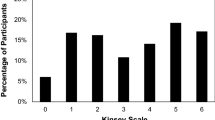Abstract
Popular song lyrics from the years 1946, 1956, 1966, and 1976, were content analyzed for feminine images. Eleven stereotyped female images were examined: woman as evil; emphasis on physical characteristics; woman's need for man; woman as a possession of man; woman as mother; woman as sex object; woman as delicate; woman as child; woman on a pedestal; woman as physically attractive; and woman as supernatural. Significant changes over time were found for 8 of the 11 images. Of the songs sampled from 1946–1976, 96% contained at least one of the female stereotypes examined in this investigation.
Similar content being viewed by others
References
Adorno, T. W. Introduction to the sociology of music. E. B. Ashton (trans.). New York: Seabury Press, 1976.
Aldag, R. J., & Brief, A. P. Some correlates of women's self-image and stereotypes of femininity. Sex Roles, 1979, 5, 319–328.
Anderson, B., Hesbacher, P., Etzkorn, K. P., & Denisoff, R. S. Hit record trends, 1940–1977. Journal of Communication, 1980, 30, 31–43.
Bandura, A. Influence of models: Reinforcement contingencies on the acquisition of imitative responses. Journal of Personality and Social Psychology, 1965, 1, 589–595.
Bandura, A., Ross, D., & Ross, S. A. Imitation of film-mediated aggressive models. Journal of Abnormal and Social Psychology, 1963, 66, 3–11.
Bankart, C. P., Bankart, B. B. The use of song lyrics to alleviate a child's fears. Child and Family Behavior Therapy, 1983, 5, 81–83.
Beattie, M. Y., & Diehl, L. A. Effects of social conditions on the expression of sex role stereotypes. Psychology of Women Quarterly, 1979, 4, 241–255.
Beauvoir, S. The second sex (H. M. Parshley, Ed. & Trans.). New York: Alfred A. Knopf, 1952.
Bem, S. L. The measurement of psychological androgyny. Journal of Consulting and Clinical Psychology, 1974, 42, 155–162.
Booth, M. W. The art of words in songs. Quarterly Journal of Speech, 1976, 62, 242–249.
Botkay, C. R. Teaching abnormal psychology concepts using popular song lyrics. Teaching of Psychology, 1982, 9, 233–234.
Busby, L. J. Sex-role research on the mass media. Journal of Communication, 1975, 25, 107–131.
Cole, R. Top songs in the sixties: A concept analysis of popular lyrics. American Behavioral Scientist, 1971, 14, 389–400.
Courtney, A. E., & Whipple, T. W. Women in TV commercials. Journal of Communication, 1974, 24, 110–118.
Crow, J. Cited in Gray Allen, That music. In J. Eisen (Ed.), The age of rock 2: Sights and sounds of the American cultural revolution. New York: Random House, 1970.
Deutsch, D. Memory and attention in music. In M. Critchley & R. A. Henson (Eds.), Music and the brain: Studies in the neurology of music. London: William Heinemann, 1977.
Freudiger, P. Love lauded and love lamented: Men and women in popular music. Popular Music and Society, 1978, 6, 1–10.
Freudiger, P., & Almquist, E. M. Male and female roles in the lyrics of three genres of contemporary music. Sex Roles, 1978, 4, 51–65.
Fried, R., & Berkowitz, L. Music hath charms ... and can influence helpfulness. Journal of Applied Social Psychology, 1979, 9, 199–208.
Frith, S. The sociology of rock. London: Constable, 1978.
Gray, M. Sexist songs. Melody Maker, 1974, 49, 18–19.
Greenburg, B. S., & Dervin, B. Use of the mass media by the urban poor. New York: Praeger Publishers, 1970.
Hesbacher, P., Downing, R., & Berger, D. G. Sound recording popularity charts: A useful tool for music research. Popular Music and Society, 1975, 4, 3–18.
Harding, C., & Ballard, K. D. The effectiveness of music as a stimulus as a contingent reward in promoting the spontaneous speech of three physically handicapped pre-schoolers. Journal of Music Therapy, 1982, 19, 86–101.
Hayakawa, S. I. Popular songs vs. the facts of life. In B. Rosenberg & D. M. White (Eds.), Mass culture: The popular arts in America. Glencoe, Ill.: Free Press, 1957.
Hyden, C., & McCandless, N. J. Men and women as portrayed in the lyrics of contemporary music. Popular Music and Society, 1983, 9, 19–26.
Infante, D. A., & Berg, C. The impact of music modality on the perception of communication situations in video sequences. Communication Monographs, 1979, 46, 135–141.
Irvine, J. R., & Kirkpatrick, W. G. The musical form in rhetorical exchange: Theoretical consideration. Quarterly Journal of Speech, 1972, 58, 272–284.
Kosokoff, S., & Carmichael, C. W. The rhetoric of protest: Song, speech and attitude change. The Southern Speech Journal, 1970, 35, 295–302.
Linoff, M. G., & West, C. M. Relaxation training systematically combined with music: Treatment of tension headaches in a geriatric patient. International Journal of Behavioral Geriatrics, 1982, 1, 11–16
Nyquist, E. B. Music as communication. Vital Speeches, 1972, 38, 202.
O'Bryant, S. L., & Corder-Bolz, C. R. The effects of television on children's stereotyping of women's work roles. Journal of Vocational Behavior, 1978, 12, 233–244.
Pearce, K. A. Effects of different types of music on physical strength. Perceptual and Motor Skills, 1981, 53, 351–352.
Riesman, D. Listening to popular music. In B. Rosenberg & D. M. White (Eds.), Mass culture: The popular arts in America. Glencoe, Ill.: Free Press, 1957.
Rodnitzky, J. L. Songs of sisterhood: The music of women's liberation. Popular Music and Society, 1975, 4, 77–85.
Roucek, J. S. Music as a factor of social control. Revista Internacional de Sociologia, 1971, 29, 117–130.
Scott, W. A. Reliability of content analysis: The case of nominal scale coding. Public Opinion Quarterly, 1955, 19, 321–325.
Shea, B. M. Content analysis of the lyrics of American popular music. Sociological Abstracts, 1973, 21, 74.
Toohey, J. V. Popular music and social values. Journal of School Health, 1982, 52, 582–585.
Wilkinson, M. Romantic love: The great equalizer? Sexism in popular music. The Family Coordinator, 1976, 25, 161–166.
Witt, D. D. Popular music as an element of culture and its effects on social behavior. Paper presented to the Midwest Sociological Society, 1978.
Author information
Authors and Affiliations
Rights and permissions
About this article
Cite this article
Cooper, V.W. Women in popular music: A quantitative analysis of feminine images over time. Sex Roles 13, 499–506 (1985). https://doi.org/10.1007/BF00287756
Issue Date:
DOI: https://doi.org/10.1007/BF00287756




